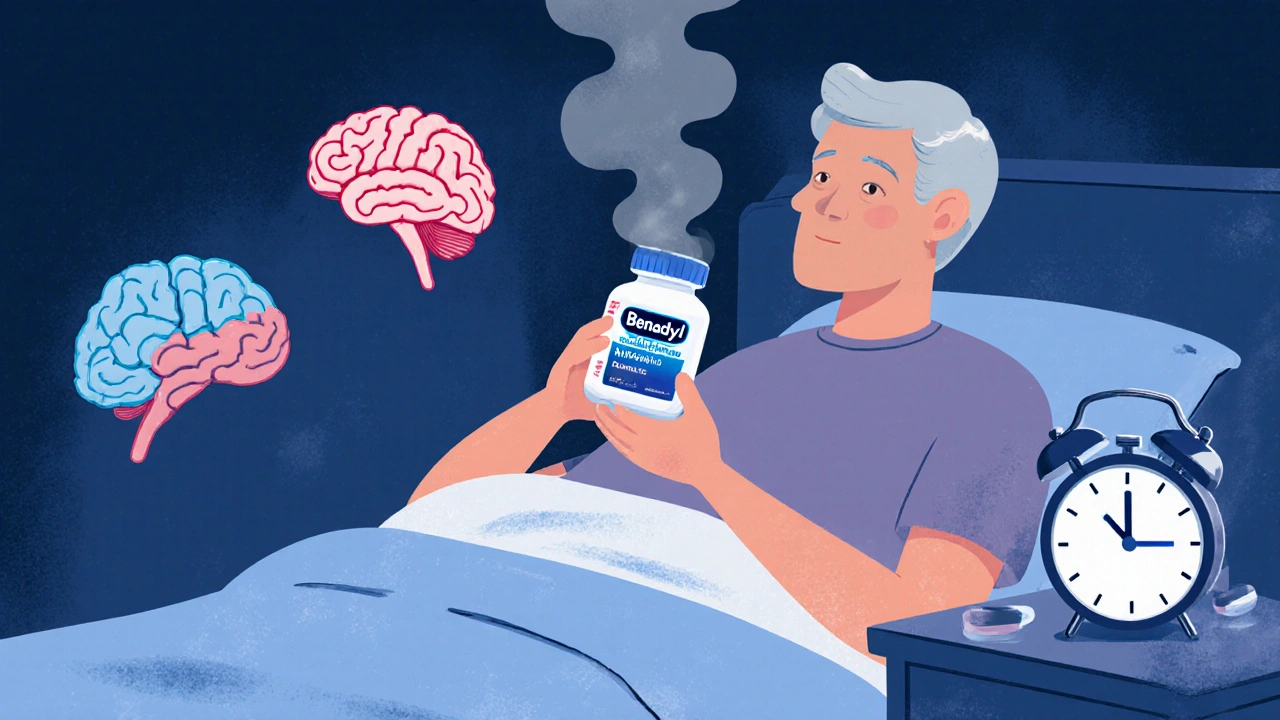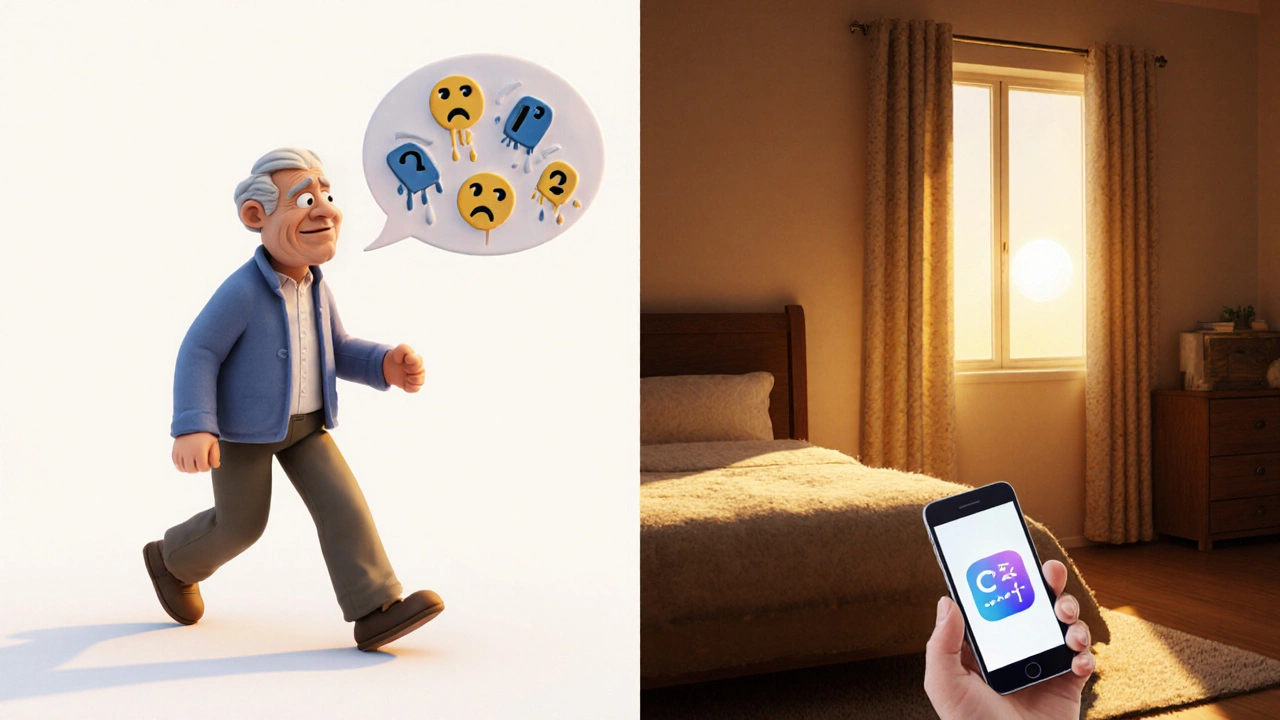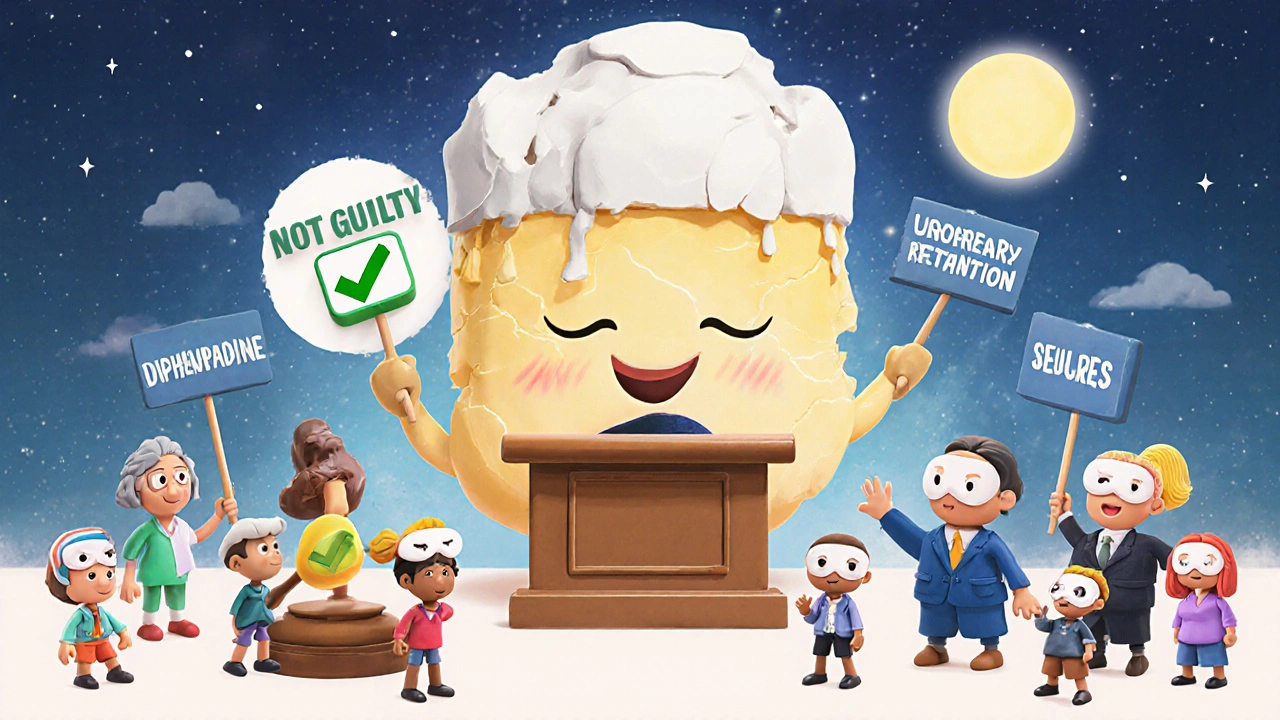Nighttime Sleep Aids with Diphenhydramine: Risks and Safer Alternatives

Oct, 31 2025
Diphenhydramine Risk Assessment Tool
Assess Your Diphenhydramine Risk
This tool calculates your personalized risk level based on your age, usage habits, and health conditions. According to the article, diphenhydramine (Benadryl, ZzzQuil) carries significant risks including memory impairment, falls, and dementia - especially for older adults.
Your Risk Assessment
Millions of people reach for diphenhydramine every night thinking it’s a quick fix for trouble falling asleep. You’ve probably seen the bright packaging-Benadryl, ZzzQuil, Unisom SleepGels-and assumed it’s harmless because it’s sold over the counter. But here’s the truth: diphenhydramine isn’t a sleep aid. It’s a sedative with serious, long-term risks that most users don’t even know about.
How Diphenhydramine Really Works
Diphenhydramine was never designed to help you sleep. It was created in the 1940s as an antihistamine to treat allergies. Its side effect? Drowsiness. That’s it. When you take it for sleep, you’re not fixing your insomnia-you’re chemically knocking yourself out. The drug blocks histamine in your brain, which normally keeps you alert. But it doesn’t stop there. It also blocks acetylcholine, a key chemical for memory, focus, and muscle control. That’s why you feel foggy the next day.Studies show diphenhydramine hits peak levels in your blood within 1 to 2 hours. Sounds fast, right? But here’s the problem: it sticks around. In younger people, it clears out in about 4 to 6 hours. In adults over 65? It can take up to 18 hours. That means if you take it at 10 p.m., you could still be half-asleep at 8 a.m. The 2021 Sleep Medicine Reviews study found 68% of users had impaired thinking, slower reaction times, and trouble concentrating the next day. That’s not just annoying-it’s dangerous. Think driving, walking down stairs, or even making a simple decision at work.
The Hidden Dangers You’re Not Being Told
The FDA says diphenhydramine is “generally safe” for occasional use. But that’s a technicality. What they don’t tell you is that “occasional” means no more than two weeks. Yet a 2022 study found 73% of people keep using it past that limit. Why? Because tolerance builds fast. After just 7 days, 68% of users say it doesn’t work as well anymore. So they take more. Or they take it every night. That’s when the real damage starts.For older adults, the risks are severe. Diphenhydramine is one of the most common anticholinergic drugs linked to dementia. A 2024 Johns Hopkins review of over 3,000 adults aged 65+ found that long-term users had a 54% higher risk of developing dementia over seven years. That’s not a small increase. That’s a major red flag. The drug doesn’t just make you drowsy-it scrambles your brain chemistry in ways that may be irreversible.
And it’s not just memory. In men over 65 with enlarged prostates, diphenhydramine can cause urinary retention so bad they need emergency catheterization. In people with glaucoma, it can trigger sudden, painful pressure spikes in the eye. Even young people aren’t safe. A 2023 FDA review reported 127 cases of seizures in children under 12 linked to diphenhydramine use. And yes-some people hallucinate. Confusion. Nervousness. Paranoia. These aren’t rare side effects. They’re documented, FDA-recognized risks.
Why Second-Generation Antihistamines Are Better
Not all antihistamines are the same. Drugs like cetirizine (Zyrtec), loratadine (Claritin), and fexofenadine (Allegra) were made to avoid the brain. They treat allergies without making you sleepy. That’s because they don’t cross the blood-brain barrier the way diphenhydramine does.A 2023 study in the Journal of Psychopharmacology compared driving performance after taking 50 mg of diphenhydramine versus fexofenadine. The diphenhydramine group performed as if they had a blood alcohol level of 0.10%-above the legal limit in every U.S. state. The fexofenadine group? No difference from sober drivers. The European Medicines Agency puts diphenhydramine in the same category as benzodiazepines for driving risk. Fexofenadine? No risk at all.
The FAA bans pilots from using diphenhydramine. Why? Because it’s too unpredictable. But they allow fexofenadine and desloratadine. If your job requires focus-if you drive, operate machinery, or care for children-you’re playing Russian roulette with diphenhydramine.

What Actually Works for Sleep
There are safer, smarter ways to fix sleep problems. First, melatonin. Not the high-dose gummies you see on shelves. Studies show 2 to 5 mg of melatonin, taken 30 to 60 minutes before bed, helps 62% of people fall asleep faster. It doesn’t knock you out. It just signals your brain it’s time to wind down. No next-day fog. No memory loss. No urinary retention.Then there’s Cognitive Behavioral Therapy for Insomnia, or CBT-I. This isn’t some trendy app. It’s the gold standard. The American Academy of Sleep Medicine says CBT-I works for 70 to 80% of people-and the results last for years. You learn how to retrain your brain to associate bed with sleep, not stress. You fix bad habits like checking the clock at 2 a.m. or scrolling in bed. You learn relaxation techniques that actually work. And you don’t need a prescription. Many online programs are covered by insurance now.
For short-term help, doctors may prescribe zolpidem (Ambien) or similar drugs. But these aren’t for daily use either. They’re for a few nights during a crisis-like after a death in the family or a major life change. The goal is always to get off them as soon as possible.
Real People, Real Stories
Look at the reviews. On Amazon, diphenhydramine sleep aids have a 4.1-star rating. But dig deeper. The positive reviews say: “Works quickly.” “Helps me fall asleep.” The negative ones? “Next-day grogginess.” “I felt like a zombie.” “I forgot where I put my keys.”On Reddit, people over 50 are posting about confusion in the morning and trouble peeing. People under 30 say it works-until it doesn’t. Then they’re taking two pills. Or adding alcohol. Or switching to something worse.
A 2023 Consumer Reports survey found 58% of diphenhydramine users had moderate to severe next-day drowsiness. Only 22% of melatonin users did. That’s not a close call. That’s a clear winner.

What You Should Do Right Now
If you’re taking diphenhydramine for sleep, stop. Don’t quit cold turkey-talk to your doctor. But start planning your exit. Here’s how:- Track your sleep for a week. Note when you go to bed, how long it takes to fall asleep, and how you feel in the morning.
- Try melatonin. Start with 1 mg, 30 minutes before bed. If nothing happens after 3 nights, try 2 mg. Most people find their sweet spot between 1 and 5 mg.
- Fix your sleep environment. No screens 1 hour before bed. Keep your room cool and dark. Use white noise if needed.
- Get sunlight in the morning. Even 10 minutes helps reset your internal clock.
- Consider a CBT-I program. Look for ones offered through your health insurer or apps like Sleepio or CBT-I Coach.
And if you’re helping an older parent or relative? Don’t let them keep using Benadryl as a sleep aid. The dementia risk is real. The falls are real. The confusion is real. Talk to their doctor. Ask about alternatives. Bring this article with you.
Why This Matters Beyond Sleep
This isn’t just about sleep. It’s about how we treat our bodies. We’ve been sold the idea that if it’s on the shelf, it’s safe. But diphenhydramine is a perfect example of why that’s dangerous. It’s cheap. It’s everywhere. It’s marketed like candy. And it’s slowly eroding people’s brains-especially the elderly.The OTC sleep aid market is worth nearly $800 million. Diphenhydramine used to be half of it. Now it’s shrinking. Why? Because people are waking up. Literally. They’re realizing that a good night’s sleep shouldn’t cost you your memory, your balance, or your safety.
You deserve rest. But you don’t deserve to trade your long-term health for a few hours of sleep. There are better ways. Start with the simplest one: stop taking diphenhydramine. Your brain will thank you.
